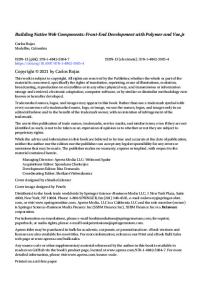Non-vacuum Thin-film CIGS Modules
- PDF / 1,225,318 Bytes
- 6 Pages / 612 x 792 pts (letter) Page_size
- 35 Downloads / 306 Views
B8.27.1
Non-vacuum Thin-film CIGS Modules Chris Eberspacher, Karen L. Pauls and John P. Serra Unisun Camarillo, CA 91320 USA ABSTRACT Non-vacuum techniques have been used to deposit coatings of copper indium gallium selenide (CIGS) and metal oxide transparent conductors useful for fabricating thin-film photovoltaic modules. Coatings are formed from nanoparticulate precursor materials using spraying, printing and spincoating methods. Sprayed layers exhibit non-planar morphologies and low particle packing, and CIGS films made from sprayed precursor layers exhibit related non-planar morphologies and residual void space. The surface roughness of spray-derived CIGS films reduces the sheet conductance of overlying coatings; thin coatings of transparent conductors deposited on rough CIGS films exhibit sheet resistances up to two orders of magnitude higher than equivalent coatings on planar surfaces. Slurry additives can improve layer morphology and sintered film properties, but organic additives can leave carbon contamination of the sintered CIGS films. The fabrication of multi-cell modules imposes additional constraints on transparent conductor sheet conductance.
INTRODUCTION Photovoltaic (PV) solar electric technology will be a significant contributor to world energy supplies when reliable, efficient PV power products are manufactured in large volumes at low costs. A promising pathway to reducing PV cost is the use of thin film technologies in which thin layers of photoactive materials are deposited on inexpensive large-area substrates. One of the most promising thin-film PV technologies is based on CuIn1-xGaxSe2 (CIGS). CIGS films and the thin-film electrodes needed to construct thin-film PV devices are typically deposited by vacuum-based techniques. While vacuum-based techniques can capture a portion of the materials cost savings inherent in thin-film concepts, a promising pathway to reducing capital intensity and functional complexity so as to further reduce costs, increase overall return on investment, and accelerate the transition to large-volume production is the use of non-vacuum techniques for forming PV thin films. Unisun has pioneered techniques for preparing high-quality PV thin films by non-vacuum techniques, including techniques based on nanoparticle materials [1-4].
EXPERIMENTAL METHODS CIGS films are formed from particulate precursor materials prepared by an aerosol pyrolysis process [5]. Typical CIGS precursor materials are solid sub-micron spheroids containing Cu, In, Ga and O [1]. Layers of precursor particles are deposited by preparing a slurry, paste or ink of precursor material with suitable solvents and dispersing agents, and spraying or printing 1-5 µm thick layers on Mo-coated soda lime glass. Porous precursor layers are converted into dense CIGS films by reactive sintering at 300-600°C.
Downloaded from https://www.cambridge.org/core. Faculty of Classics, University of Cambridge, on 15 Sep 2017 at 20:26:15, subject to the Cambridge Core terms of use, available at https://www.cambridge.org/core
Data Loading...











